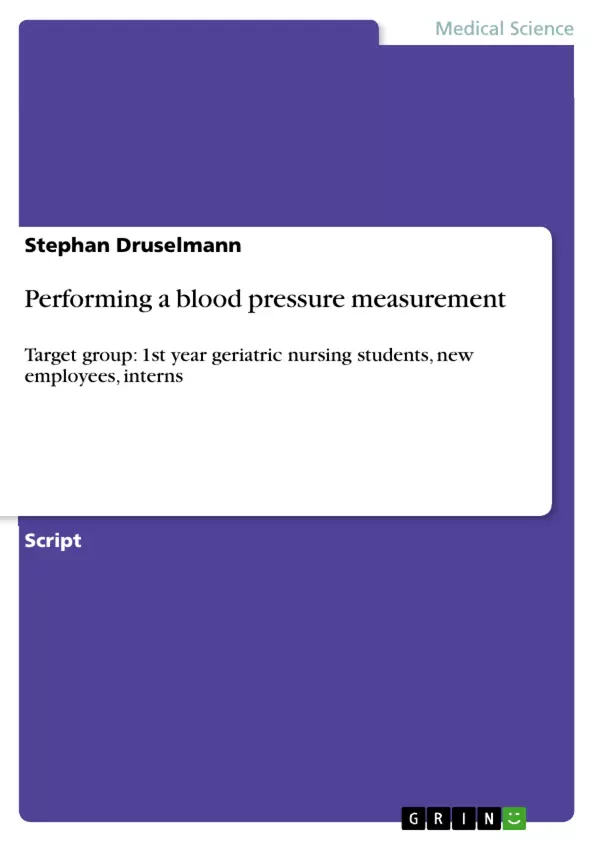Instructions for blood pressure measurement for the trainee
Blood pressure measurement is an everyday routine nursing task. Every nurse must be able to take a blood pressure reading and respond adequately to any changes.
Students of geriatric nursing should be trained as early as possible to independently recognize the necessity of blood pressure measurement, especially in emergency situations, and be enabled to perform it routinely. The learner should be gradually enabled to perform his or her professional duties independently.
Learners in learning processes are dependent on the cooperative collaboration of the practice instructor and the respective nursing team in practice.
Careful and competent explanation of all work processes, their theoretical significance and correct practical execution by the practice supervisor is of great importance.
Inhaltsverzeichnis (Table of Contents)
- Introduction
- Importance of the instruction of blood pressure measurement for the trainee
- Condition analysis
- Subject
- Target group
- Legal basis¹
- German Elderly Care Act (AltPfIG)
- German Training and Examination Ordinance (AltPflAPrV)
- Framework curriculum
- Care Act
- General conditions
- Importance of education/training in the institution
- Organisation of training in the institution/living area
- Objectives
- Method
- Didactic structuring and design/ implementation of the instructions
- Reflection
Zielsetzung und Themenschwerpunkte (Objectives and Key Themes)
This document aims to provide a comprehensive guide for teaching nursing students the crucial skill of blood pressure measurement. It focuses on the importance of this skill for trainee nurses, outlines the relevant legal frameworks and practical considerations, and examines the best methods for didactic structuring and implementation of training instructions.
- Importance of blood pressure measurement for nursing trainees
- Legal and practical frameworks surrounding blood pressure measurement training
- Didactic approaches to designing and implementing blood pressure measurement training
- Relevance of personnel, communicative, and methodological competence in training
- Importance of a supportive and collaborative learning environment
Zusammenfassung der Kapitel (Chapter Summaries)
- Introduction: This chapter emphasizes the critical importance of blood pressure measurement competency for nursing students, highlighting its relevance in everyday practice, emergency situations, and the gradual development of independent nursing skills.
- Condition Analysis: This section defines the subject matter of blood pressure measurement training, identifies the target group of nursing students, and explores the legal basis for this training. It reviews key regulations like the German Elderly Care Act (AltPfIG), the German Training and Examination Ordinance (AltPflAPrV), and the framework curriculum, as well as the Care Act.
- Objectives: This chapter will likely outline the specific learning objectives and expected outcomes for trainees participating in the blood pressure measurement training program. These objectives are likely to align with the relevant legal and regulatory frameworks.
- Method: This section delves into the methodologies and approaches chosen to deliver the blood pressure measurement training. It may describe teaching methods, training materials, and assessment strategies.
- Didactic Structuring and Design/Implementation of the Instructions: This chapter will likely focus on the practical aspects of designing and implementing the training program. This could include information on the content structure, teaching strategies, and the use of learning resources.
Schlüsselwörter (Keywords)
The key concepts explored in this document include blood pressure measurement, nursing training, didactic structuring, legal frameworks, nursing competence, personnel competence, communicative competence, methodological competence, and the importance of a supportive learning environment.
- Arbeit zitieren
- Stephan Druselmann (Autor:in), 2009, Performing a blood pressure measurement, München, GRIN Verlag, https://www.hausarbeiten.de/document/1222607


